report
Status: 04/16/2022 08:20 a.m
Cairo is choking on traffic. The government is therefore building roads and historic sites are disappearing. This fate now threatens one of the oldest cemeteries, where poor families also live.
Wahid al-Mardelli follows in the footsteps of his ancestors. They are buried in an ornate mausoleum, in alabaster sarcophagi, surrounded by a lush palm garden. “This is the tomb of Prince Muhammad Fadel Pasha al-Dramali – my great-grandfather,” he says. “It is decorated with a fez – the traditional headwear from the Ottoman era. The tomb with the crown there is my grandmother’s tomb.”
In contrast to almost every other place in Cairo, there is silence here – not even the traffic of the metropolis can be heard in the so-called City of the Dead, one of the largest and oldest cemeteries in the city.
“The history of these cemeteries covers the history of Egypt since the Islamic conquest, more than 1,400 years – the era of the Mamluks, the Ottomans and that of Muhammad Ali’s family. The entire history is represented here,” says Mustafa Al-Sadiq. The amateur historian has studied the history of the cemetery intensively and wants to prevent it from being destroyed. Because that’s the Egyptian government’s plan: They want to build an expressway. There, where elaborately decorated tombs and marble-topped mausoleums stand today.
Families who have no money to rent an apartment have settled between the graves.
Image: Anne Allmeling, ARD Studio Cairo
“Buildings like little palaces”
“If all of that is demolished, a lot of people will be hurt. There will be a loss of culture and history, a loss of all these works of art,” says Al-Sadiq. “Most of the buildings here look like small palaces, not tombs. There are different styles; the Mamluk style and other styles. No country would give up such things easily. Why are we doing this?”
New roads and bridges are being built in many places in Cairo to smooth out traffic and prevent the many traffic jams in the city. But sacrifice cultural heritage for this? Al-Sadiq cannot understand this. “We only have our history. And we are proud of it. Our history is priceless. All the countries around us that have a lot of money cannot buy history. On the contrary: they come to us for antiques and sell them in Exhibiting museums” – that’s how he sees it. “Of course we’re not against development, but new projects shouldn’t come at the expense of our history and our monuments.”
One of the residents is 27-year-old Ramy. He’s been living in the necropolis all his life.
Image: Anne Allmeling, ARD Studio Cairo
Urban planning without consideration for the poor
For Ramy, the City of the Dead is his home. The 27-year-old grew up here – in a small house between two graves that look like houses themselves. Affordable housing is scarce in Cairo. That’s why people who don’t have the money to rent an apartment have settled in the Totenstadt.
Ramy has to provide himself with electricity and water. Despite this, he loves his surroundings. “I was born and raised here. If I had to move away, it wouldn’t be a life,” he says.
Ramy’s home is anything but luxurious: a narrow hallway leads to a dark room with a small kitchen, a narrow staircase to the first floor. But Ramy is attached to the small house where his grandmother used to live. He can walk to his workplace from here: he works in a workshop and repairs broken cars. If he were to be relocated at some point, that would pose problems for him: “Every trip here and back would cost me my daily wages.”
Ramy’s sparsely furnished kitchen.
Image: Anne Allmeling, ARD Studio Cairo
Across the street, directly across from his house: The National Museum of Egyptian Civilization – a new prestige project of the Egyptian government. She wants to attract tourists. But Ramy and his neighbors do not benefit from this. Environmental law attorney Ahmed El-Saidy criticizes that it’s urban planning by decree that doesn’t take the poorest into account: “The Egyptian constitution always talks about sustainable development, that is, development that takes all aspects of life into account: be it the social, economic, ecological or archaeological development, but if there is no public consultation for such projects, sustainability is compromised and the population does not agree with it.” More and more historical buildings are disappearing from Cairo’s cityscape – in favor of expressways and new apartments.
Open cemetery for tourists?
Architect Hany El-Fekky, who is responsible for the latest project, says: otherwise there would be a traffic gridlock near the city of the dead. “It’s very important that we build this road. Otherwise, cars will be driving here at five kilometers an hour. That means time is wasted and people are prevented from working. It’s also a waste of energy, petrol and diesel, and it’s polluting the environment,” he argues.
Paved roads, electricity and water – Ramy would like all of that too. But he doesn’t want to leave the neighborhood where his family and friends live. Ramy still knows every corner, every stone in the Totenstadt. If he has his way, it should stay that way. Waheed al-Mardelli is also committed to this.
The 76-year-old does not want to let the government’s arguments stand. Instead of tearing down parts of the historic cemetery, the city of the dead should be used, he says – and open it to tourists: “We estimate the number of tourists who would come here to be nine million.” They could give the state a lot of revenue, he says.
Income that the state could use well. According to official figures, about a third of the population in Egypt lives below the poverty line.
Gentrification in Cairo: Historic necropolis to give way to expressway
Anne Allmeling, ARD Cairo, April 13, 2022 10:54 a.m

